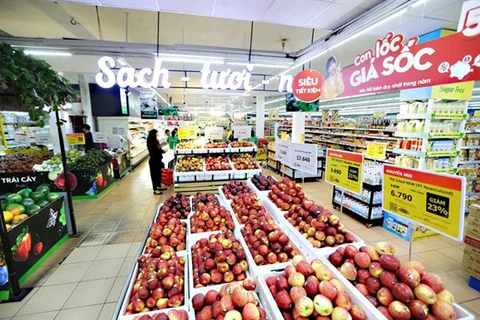Hanoi (VNA) - Catching up with new retail trends to bring a new shopping experience to customers will help Vietnamese retailers seize the lion’s share of the market, especially after a number of foreign players have shut up their shops, according to insiders.
Domestic retail market heating up
An expanding middle class and higher incomes will see Vietnam’s retail and services revenue rise 1.6-fold against 2020 to 350 billion USD by 2025. The country’s retail market is therefore thought to have become an attractive destination for foreign investors.
Posting solid growth of 6.8 percent last year amid COVID-19, the local market has considerable potential but is marked by fierce competition that requires companies develop sensible retail sales models to win customers.
Vietnam’s retail market has witnessed substantial changes in market share over recent years, with an array of merger and acquisition (M&A) deals clinched. Most recently, on March 1, retail chain Big C, the long-standing supermarket chain run by Thailand’s Central Group, had its brand identity changed to Tops Market and Go! after 22 years in Vietnam. Last year, the Republic of Korea’s largest supermarket chain, Emart, decided to pull out of Vietnam after five years of trying to expand its network since it opened the first outlet in HCM City.
Five years ago, foreign investors held more than 50 percent of the market share. Domestic retailers are now gaining the upper hand, however, scaling up outlets nationwide.
According to the Ministry of Industry and Trade’s Domestic Markets Department, Vietnam has some 1,085 supermarkets, 240 shopping malls, and nearly 2,000 convenience stores, 70-80 percent of which are operated by Vietnamese retailers. In the past, local companies made efforts to consolidate their market share in large cities and provinces while working to expand rural markets. Experts described this strategy as sensible, since it meets customer demand.
Appropriate retail sales models needed
Vietnamese retailers should develop retail sales models that are suitable for their target markets, experts have said, explaining that this is a decisive factor in success.
The local retail market changed dramatically in 2020, especially consumer shopping habits, and these changes are here to stay.
E-commerce is expected to boom this year as more consumers have moved to shopping online due to COVID-19. According to the Ministry of Industry and Trade’s E-Commerce and Digital Economy Agency, online retail sales reached nearly 12 billion USD in 2020, a year-on-year increase of 18 percent, or 5.5 percent of the country’s total retail sales and services revenue.
Local firms need to develop multi-channel retailing to meet the diverse demands of customers. They should also take advantage of technology to gain a competitive edge over their foreign rivals./.
Five years ago, foreign investors held more than 50 percent of the market share. Domestic retailers are now gaining the upper hand, however, scaling up outlets nationwide.
According to the Ministry of Industry and Trade’s Domestic Markets Department, Vietnam has some 1,085 supermarkets, 240 shopping malls, and nearly 2,000 convenience stores, 70-80 percent of which are operated by Vietnamese retailers. In the past, local companies made efforts to consolidate their market share in large cities and provinces while working to expand rural markets. Experts described this strategy as sensible, since it meets customer demand.
Appropriate retail sales models needed
Vietnamese retailers should develop retail sales models that are suitable for their target markets, experts have said, explaining that this is a decisive factor in success.
The local retail market changed dramatically in 2020, especially consumer shopping habits, and these changes are here to stay.
E-commerce is expected to boom this year as more consumers have moved to shopping online due to COVID-19. According to the Ministry of Industry and Trade’s E-Commerce and Digital Economy Agency, online retail sales reached nearly 12 billion USD in 2020, a year-on-year increase of 18 percent, or 5.5 percent of the country’s total retail sales and services revenue.
Local firms need to develop multi-channel retailing to meet the diverse demands of customers. They should also take advantage of technology to gain a competitive edge over their foreign rivals./.
VNA

























